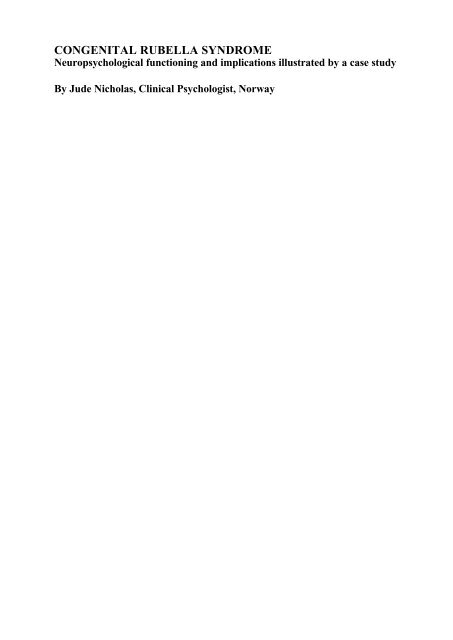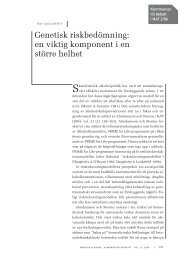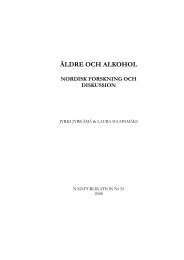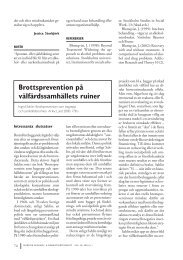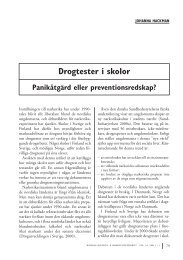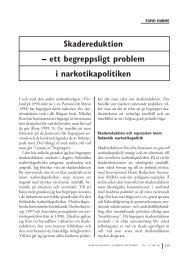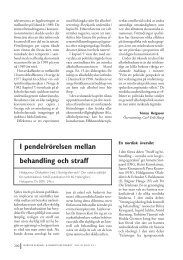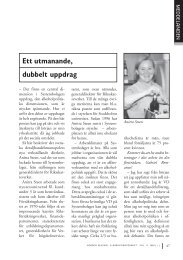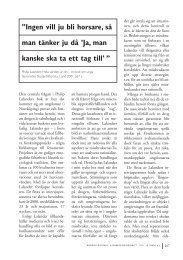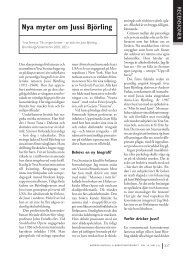CONGENITAL RUBELLA SYNDROME
CONGENITAL RUBELLA SYNDROME
CONGENITAL RUBELLA SYNDROME
Create successful ePaper yourself
Turn your PDF publications into a flip-book with our unique Google optimized e-Paper software.
<strong>CONGENITAL</strong> <strong>RUBELLA</strong> <strong>SYNDROME</strong><br />
Neuropsychological functioning and implications illustrated by a case study<br />
By Jude Nicholas, Clinical Psychologist, Norway
<strong>CONGENITAL</strong> <strong>RUBELLA</strong> <strong>SYNDROME</strong><br />
Neuropsychological functioning and implications illustrated by a case study<br />
By Jude Nicholas, Clinical Psychologist, Norway<br />
Preface<br />
My work with persons with congenital rubella syndrome (CRS) was presented at a<br />
conference on adult persons with CRS at the Nordic Staff Training Centre for<br />
Deafblind Services (NUD) in May 1999. After my presentation I was asked by the<br />
director of NUD, Anny Koppen, to write an article describing my work, which<br />
could be included in the Nordic Directory for Staff in Deafblind Services as one of<br />
its publications.<br />
I would like to thank gratefully Professor Hallgrim Kløve at the University of<br />
Bergen for his professionally inspiring guidance and support for my work.<br />
I also thank my colleagues at the Regional Centre for Deafblind Persons in Bergen<br />
for going through my manuscript. In particular I have appreciated Jan Ottar<br />
Hermansen's and Harald Haldorsen's enthusiasm.<br />
Many thanks to Nordic Staff Training Centre for Deafblind Services, which made<br />
this publication possible. Especially thanks to Elin Østli for good co-operation on<br />
this project.<br />
Last, but not least I would like to thank Stan Munroe, The Canadian Rubella<br />
Association and Norman Brown, Birmingham University and Sense for their very<br />
good suggestions regarding this English translation of the Norwegian original.<br />
Vestlandet Resource Centre, July 2000<br />
2<br />
Jude Nicholas
The structural variation of the higher mental functions at<br />
different stages of ontogenetic development means that their<br />
cortical organization likewise does not remain unchanged<br />
and that at different stages of development they are carried<br />
out by different constellations of cortical zone... (thus)... the<br />
character of the cortical intercentral relationships does not<br />
remain the same at different stages of development of a<br />
function and.… the effects of a lesion of a particular part of<br />
the brain will differ at different stages of functional<br />
development.<br />
(Luria, 1980, p. 34-35)<br />
<strong>CONGENITAL</strong> <strong>RUBELLA</strong> <strong>SYNDROME</strong><br />
Neuropsychological functioning and implications illustrated by a case study<br />
Introduction<br />
Rubella is also known as German Measles. When the rubella virus infects children<br />
or adults normally a slight and self limiting illness develops, with rash like red<br />
spots, swollen glands, low-grade fever, running eyes, sore throat and aching joints.<br />
In some cases the symptoms of infection are too mild to notice.<br />
The disease German Measles was first described more than 200 years ago. Only in<br />
1941, however, the high incidence between rubella infection during early<br />
pregnancy and congenital cataracts was observed by the Australian<br />
ophthalmologist Sir Norman Gregg. Gregg also reported that low birth-weight,<br />
congenital heart defects, deafness and nutrition problems were over-represented<br />
among children born with German Measles (Givens et al, 1993). It was not until<br />
1962 that one was able to isolate the rubella virus, and in 1966 it was announced<br />
that vaccination against the disease had been developed. Today many countries<br />
have implemented a routine immunisation programme for all infants at the age of<br />
about 15 months, in some countries followed by revaccination of both sexes before<br />
puberty.<br />
The 1960s' pandemic is believed to have affected 12.5 million individuals worldwide<br />
(Munroe, 1999). Despite the fact that today, congenital rubella is a low<br />
frequency aetiology for hearing impairments and deafblindness in our part of the<br />
world, there are many congenitally deaf and deafblind young and adult persons<br />
whose sensory impairments are caused by rubella. Just a few decades ago maternal<br />
rubella was an important cause of congenital deafblindness.<br />
Rubella virus is generally acquired by airborne distribution, and enters the<br />
maternal respiratory tract (McCracken, 1963). The risk of congenital impairments<br />
due to rubella is relative to the age of the foetus at the time of infection. The risk of<br />
impairments are estimated to be 40 - 60% with infections during the first eight<br />
3
weeks, 30 - 35% during the third month of pregnancy and around 10% with<br />
infections during the fourth month (Dudgeon, 1967). Van Dijk (1991) has shown<br />
that children with cataracts in both eyes were infected during the first two months<br />
of pregnancy, when the lens of the eye is developing and rapidly changing, and<br />
thus vulnerable when exposed to the effects of the virus. After the tenth week of<br />
pregnancy, when the lenses are fully developed, they are probably sufficiently<br />
protected against the damaging effects of the rubella virus. Damages from<br />
infections later than the tenth week of pregnancy are therefore likely to be<br />
restricted to the inner ear and can entail deafness. The Organ of Corti is the part of<br />
the inner ear, which links the ear and the brain, and is often the structure which is<br />
damaged by rubella.<br />
Both early and late manifestations have to be considered in connection with<br />
congenital rubella syndrome or CRS for short.<br />
Early manifestations of CRS may be a combination of hearing impairment,<br />
congenital cardiac problems (ventricular septum defect), visual impairments<br />
(cataracts) and neurological problems of various types (microcephaly, cerebral<br />
palsy, hypotonia, poor balance, dysco-ordination and mental retardation). The<br />
embryo genetic timetable indicates that the most rapid development of the heart<br />
muscle occurs at much the same time as the inner ear and lenses are developing.<br />
Therefore damage to the ears and eyes is often accompanied by a variety of heart<br />
defects (van Dijk, 1982). While the disease is in its outbreak, one could find<br />
damaging conditions like hypoxia (reduced provision of oxygen) and acidosis<br />
(high acid levels in the body) (Rorke, 1973). Damage or disability not related to<br />
rubella is always possible, even if it is unlikely.<br />
Autistic-like behaviour is often seen among children with congenital rubella<br />
syndrome (Chess, 1977). According to van Dijk (1991) there is no biologically<br />
conditioned link between rubella and autism. The ritualistic behaviours<br />
demonstrated by children with CRS are not manifestations of autism, but rather a<br />
consequence of sensory deprivation (van Dijk, 1982).<br />
Children with CRS may later in life develop new symptoms (referred to as delayed<br />
or late manifestations). These manifestations may have their onset during early<br />
teens, late teens, young adulthood or later (O'Dea and Mayhall, 1988). The<br />
symptoms include change in hearing ability, visual problems (acquired glaucoma,<br />
detached retina ) diabetes (insulin dependent Diabetes Mellitus), thyroid conditions<br />
(usually hypothyroidism), gastrointestinal difficulties, vascular problems<br />
(hypertension), psychosocial problems (withdrawal, reduced frustration threshold<br />
and depressed mood), epilepsy, behavioural problems (impulsive behaviour,<br />
concentration problems and attention deficiencies). The causes of these late<br />
manifestations are unclear. Many think that these new symptoms are due to a<br />
persistent infection of the rubella virus in the affected organ, or that the old<br />
4
infection sets up an autoimmune response. It is important to note that not all<br />
persons with CRS will develop such late manifestations.<br />
The central nervous system is affected in several ways. The presence of the rubella<br />
virus in the central nervous system, the auditory and visual nerves included, may<br />
lead to infectious conditions like leptomeningitis, encephalitis, vasculitis and may<br />
reduce cell division in the embryo. Viral infections like rubella may disturb the<br />
formation and migration of nerve cells and entail reduced cortical maturation<br />
(Smith, 1996). In addition the virus may lead to overall retardation in the formation<br />
of myelinated fibres (Rorke & Spiro, 1967).<br />
Myelin, a fatty substance that wraps around some nerve fibres, lets nerves transmit<br />
signals faster and more efficiently. Although, myelination occurs in certain neural<br />
regions prenatally (e.g. certain pathways of the spinal cord), the majority of the<br />
fibrous tracts of the central nervous system are not fully myelinated until the first<br />
few postnatal years. Even then, the myelination process may continue until puberty<br />
or adulthood (Altman, 1967).<br />
Computed tomography (CT) findings correlate with the degree of developmental<br />
retardation otherwise observed in children with CRS (Ishikawa et al., 1982).<br />
According to van Dijk (1997) prenatal infections such as rubella and<br />
cytomegalovirus (CMV) may damage the central nervous system to such a degree<br />
that the orienting response and the speed of habituation may be affected. Research<br />
on the speed of habituation shows that biological disorders can influence cognitive<br />
potential in a negative way. It is assumed, that the ability to habituate and how<br />
quickly a person habituates are expressions of the maturation of the central nervous<br />
system (Rovee-Collier, 1987).<br />
Orienting response and habituation<br />
Children normally learn to interpret, understand and adapt to their environment<br />
through meaningful and integral interaction with the environment. This adaptation<br />
is conditioned by the brain's ability to perceive and process the information coming<br />
from the senses (auditory, visual and tactile). Children are exposed to a continuous<br />
stream of experiences and have to habituate or cease reacting to some of them in<br />
order to be able to direct the attention to another specific stimulus. This is a natural<br />
part of children's everyday behaviour. In other words, children choose which<br />
stimuli in the environment they want to pay attention to. This is the simplest of all<br />
forms of learning.<br />
New stimulation most often makes the individual orient towards the stimulus and<br />
prepare for action. This is referred to as the orienting response or orienting reflex<br />
(e.g. we direct our attention towards the source of an unknown noise). The<br />
orienting response has been interpreted as reflecting the anticipatory process<br />
5
during which the future consequences of the stimulus are being evaluated. The<br />
orienting response thus makes the organism ready for organised behaviour (van<br />
Dijk, 1997). The orientating response may be easily observed (e.g. focusing of the<br />
eyes/turning of head) or it can provoke changes in the autonomous nervous system<br />
(e.g. increase of muscle tone/ changes in pulse rate or skin responses).<br />
When an organism is repeatedly presented with a stimulus that is not consistently<br />
associated with any particular consequence, the organism may cease to respond to<br />
the stimulus. This process is known as habituation. Habituation is generally<br />
defined as a decrement in response to an initially novel stimulus when it is given<br />
repeatedly. In other words, the novelty of the stimulation diminishes.<br />
Habituation is characterised as the filtering of irrelevant sensory impressions. This<br />
means that habituation serves to eliminate inappropriate responses to stimuli that<br />
carry no serious consequences, and is therefore quite adaptive. Habituation holds<br />
for many everyday events. We have become so accustomed to the ticking of a<br />
clock that we are utterly unaware of it until it finally stops. By the same token,<br />
people living close to a waterfall will get used to its roar after some time, and not<br />
even notice it.<br />
To begin with, we can say that habituation is a reduction of the orienting response<br />
to a given stimulus. However, we have to distinguish habituation from adaptation<br />
and fatigue/exhaustion. Adaptation is often a lack of response due to processes<br />
limited to sensory receptors. On the contrary, fatigue/exhaustion is a lack of<br />
response due to processes limited to the muscle, neuromuscular junction or other<br />
effectuation organs. It is only when the lack of response is caused by a process<br />
within the central nervous system, i.e. changes in interneuron activity, that we use<br />
the term habituation.<br />
We can distinguish habituation from adaptation and fatigue by looking at the<br />
responses following new stimulation. Presentation of another (usually extra strong)<br />
stimulus causes restoration of the response. This is called dishabituation. If, again,<br />
the first stimulus is presented, i.e. the stimulus to which the person was habituated,<br />
the person will again show orienting response. In other words, the person shows a<br />
subsequent recovery of attention when a new stimulus is presented.<br />
It is important to note that the orienting responses and their habituations are the<br />
constituents of a very important self-regulating system. Self-regulation is the<br />
ability to regulate one’s own behaviour, which requires the subject to shift course<br />
of thought and action according to the demands of the situation.<br />
Impaired habituation can reduce the efficiency of and slow cognitive processing,<br />
such as that caused by rubella infection. Habituation is a predictor of cognitive<br />
development and an essential element in attentional cognitive processing. For<br />
example, habituation allows the nervous system to prepare for a change in focus of<br />
6
attention to the next important stimulus. When our attention is evoked by a new<br />
stimulus the activating system is affected.<br />
Habituation and arousal<br />
The level of arousal or the physiological activation of the nervous system are<br />
related to behaviour and are described as a correlate to or consequence of action.<br />
Habituation is closely related to the concept of arousal, which is an important<br />
dimension within neuropsychology. In general, one could relate the concept of<br />
arousal to an “intensity dimension” of behaviour and in a neurological context it<br />
may represent the degree of cortical activation. Arousal may reflect the degree of<br />
activity in a central activating system, which will be reviewed later. Thus the<br />
concept of arousal could be candidate to a fundamental explanatory principle of<br />
human behaviour. Luria (1973) maintained that the general arousal level is<br />
dependent on several factors, such as sensory input, metabolic processes, and<br />
cortical functioning.<br />
Figure 1<br />
Behavioural Arousal and Performance<br />
Different levels of arousal can be observed in terms of behavioural states. It is<br />
assumed that the degree of arousal varies along a dimension from deep sleep or<br />
pathological coma on one hand to a hyperaroused state of emotional and cognitive<br />
chaos or panic on the other hand. An organism's normal arousal level will be found<br />
7
somewhere between these extremes. Malmo (1959) has demonstrated that the<br />
relationship between performance and arousal level can be described as an inverse<br />
curve, where both very low and very high levels of arousal result in an impairment<br />
of functioning and performance (see fig. 1). This means that at low levels of<br />
arousal there is poor performance, and when the level of arousal increases,<br />
performance will increase, until a certain limit. If the level of arousal exceeds this<br />
limit, performance will drop again. Both very high and very low arousal levels<br />
interfere with functions such as attention, concentration, cognition and emotional<br />
control.<br />
The u-curved relationship between performance and arousal can be explained by<br />
the information processing theory. The concept of arousal may indeed represent a<br />
fundamental principle governing the interaction of the organism with its<br />
environment and influencing the manner in which information about the<br />
environment is stored and retrieved. A prerequisite for processing cognitive and<br />
emotional information and for responding adequately is that the person is in a<br />
favourable state of arousal (Grøttland, Jacobsen and Andreassen, 1998). Thus, in<br />
order to function normally and adequately it is necessary that the individual has an<br />
optimal level of arousal.<br />
Individuals fluctuate about particular optima and their behaviour is designed to<br />
maintain a desirable equilibrium. Individuals vary in the equilibrium state, which<br />
they find pleasurable or tolerable, and in the clinical case the optimal state may<br />
preclude normal functioning. Stress responses could also be explained within the<br />
framework of arousal and activation theory (Eriksen, 1998). The stress response<br />
occurs whenever there is discrepancy between what the organism is expecting, and<br />
what really happens.<br />
The physiological basis for variation in behavioural states is present already at<br />
birth. Environmental factors and the neurological maturation of the cortex<br />
contribute to stabilise and regulate these states (Grøttland et al., 1998). Field<br />
(1981) has presented a model for infants' attention and positive affect during early<br />
interactions, based on the theory of optimum level of arousal. Atypical children,<br />
e.g. prenatal cocaine- exposed children or rubella children, may show distorted<br />
patterns of arousal, and this may negatively affect these children's ability to direct<br />
and sustain attention. For example, Mayes et al. (1993) have shown that cocaineexposed<br />
newborns obtained significantly lower scores than control children on the<br />
habituation cluster on a neonatal behavioural scale, which measured the regulation<br />
of attention in neonates. This means that it may be more challenging to regulate<br />
these children's attention and affective expressions in situations of interaction<br />
(Smith and Ulvund, 1991).<br />
The measures of state of arousal have been many. Different neurophysiological<br />
and psychophysiological methods could be used to measure the level of arousal<br />
and habituation (e.g. EEG, Event Related Potentials and heart rate responses).<br />
8
Presentation of visual stimuli and pupillary responses have also been used to<br />
measure arousal and habituation (Kim, Beversdorf & Heilman, 2000).<br />
Arousal level and habituation is normally measured by registering the skin<br />
conductance reaction to sound. In the test situation the person is exposed to<br />
auditory stimulation with varying intervals. The human skin has properties of<br />
electrical conductance, as well as electrical resistance. The measurement of the<br />
electro-physiological activity of the skin (Skin Conductance, Galvanic Skin<br />
Resistance, and Skin Potentials) reflects activity in the autonomous nervous<br />
system. The autonomic sympathetic activity is influenced by the arousal or<br />
activating system. Skin conductance tests are applied to assess the ability of the<br />
brain stem to perform normal reaction. For example, studies by Satterfield &<br />
Dawson (1971) and by Kløve & Hole (1979) found that hyperactive children had a<br />
lower skin conductance level and a more rapid habituation rate to auditory stimuli<br />
than control children, thus indicating a state of central hypoarousal in hyperactive<br />
children.<br />
The activating system of the brain<br />
When we refer to activation or arousal, we are talking about the generalised,<br />
undifferentiated, central activating system response which has two important<br />
dimensions: the general activation of the cortex and the general activation of the<br />
nervous system, notably the sympathetic part.<br />
This activating system of the brain consists of the reticular formation and certain<br />
other subcortical structures (thalamus among others). The reticular formation is<br />
localised in the brain stem. The reticular activating system plays a crucial role not<br />
only in activating the cortex but also for behavioural arousal. Independently of the<br />
source of stimulation this system produces excitatory effects on the cortex, and<br />
through this mechanism the organism can be awakened or aroused by various<br />
stimuli. Moruzzi and Magoun (1949) found that the stimulation of the reticular<br />
formation led to cessation of cortical electrical activity characteristic of drowsiness<br />
and sleep, and a switch to electrical activity associated with wakefulness.<br />
According to Luria (1973) the role of the activating system is to maintain an<br />
optimal level of cortical tone which is essential for the organised course of mental<br />
activity.<br />
The reticular formation consists of diffuse collections of cells and fibres in the<br />
central core of the brain stem. It stretches from the spinal cord and up to the<br />
thalamus and has connections to several parts of the brain (Brodal, 1990). Fibres<br />
from each of the sensory systems (with the exception of the olfactory system) send<br />
off branches to the reticular formation as they pass through the brain stem on their<br />
way to the cortex. The reticular formation is sometimes called a non-specific<br />
9
sensory system, because in some experiments it has been possible to stimulate the<br />
structure alone and produce the cortical and behavioural effects of arousal.<br />
The reticular activating system has effects on all the functions in the central<br />
nervous system (see figure 2). Particular attention has been drawn to the<br />
importance of the reticular activating system in relation to its excitatory and<br />
inhibiting functions, or in other ways regulating the activities of the central<br />
nervous system.<br />
Figure 2<br />
The Reticular Activating System (RAS) showing its inputs from sensory tracts in the brainstem and its<br />
projections to the hypothalamus, and the thalamus, which in turn project to the cerebral cortex.<br />
We can imagine that a certain "activity tone" in the reticular formation is<br />
maintained by impulses from all parts of the nervous system, and that the impulses<br />
vary in types and in quantity. It has been shown that the activity in the reticular<br />
formation is necessary for the conscious perception of, and adequate reactions to,<br />
specific sensory stimulation. The evidence is overwhelming that the reticular<br />
formation is a necessary prerequisite for activation. This relationship is frequently<br />
distorted in the presence of subcortical-division dysfunctions. Viral infections,<br />
such as rubella can affect the neural integration of the reticular activating system.<br />
Partial interruptions in the reticular activating system may produce selective<br />
cognitive deficits. Dysfunctions of the reticular activating system may be<br />
associated with deterioration or disorganisation of particular cognitive functions,<br />
such as disruptions of attention and concentration, memory disturbances, and it<br />
may also affect emotional adaptability (Kløve, 1995).<br />
Reticulo-frontal connections<br />
10
The brainstem reticular formation responsible for orienting, activation and arousal<br />
seems to be closely related to the cortex, mainly to its frontal parts (prefrontal<br />
cortex). The intimacy between the reticular system and the frontal lobes (reticulofrontal<br />
connections) has been shown both neuroanatomically (Kievit and Kuypers,<br />
1975; Nauta, 1971) and functionally (Damasio, 1985; Luria, 1980). The bidirectional<br />
nature of the reticulo-frontal interactions has also been demonstrated<br />
electrophysiologically (Homskaya, 1970). Neuroanatomically it has been shown<br />
that the mesencephalon (midbrain: ventral portion) is the main point of origin of<br />
reticular projections into the prefrontal cortex (Nauta & Domesick, 1981). Watson,<br />
Valenstein & Helman (1981) have stressed the importance of cortico-midbrain<br />
reticular loops for activation and arousal.<br />
Because of the intimate relationship between the reticular system and the prefrontal<br />
cortex, it is virtually predictable that the damage to reticulo-frontal projections will<br />
produce a damage, which looks like a frontal lobe damage. Damages in the frontal<br />
lobe are clinically observed as inability to initiate actions, inability to switch from<br />
one activity to another (cognitive rigidity and perseveration), inability to plan and<br />
structure behaviour, poor impulse control and impairment in judgement and insight<br />
(Schanke, 1992). Although the frontal lobes are vulnerable in head trauma, these<br />
symptoms can be found in the absence of obvious structural lesions within the<br />
frontal lobes (Stuss & Benson, 1987). Lesions outside the frontal lobe can cause<br />
the neuropsychological picture of the frontal lobe damage per se, which interferes<br />
with reticulo-frontal projections. It is proposed that any brain dysfunction affecting<br />
the reticulo-frontal interactions constitute a "reticulo-frontal disconnection<br />
syndrome" (Goldberg, Bilder, Hughes, Antin & Mattis, 1989).<br />
Neuropsychological aspects of CRS<br />
Few studies have dealt with neuropsychological deficits in persons with congenital<br />
rubella syndrome. Individuals with CRS are found to have a high incidence of<br />
certain behaviours (O'Donnell, 1995). Vernon (1967) has reported that children<br />
deaf from rubella have more psychological difficulties than children who are deaf<br />
from other causes.<br />
Individuals with CRS have been noted to have certain behavioural disturbances<br />
such as attentional difficulties, impulsivity and low frustration tolerance (O'Dea<br />
and Mayhall, 1988). A Canadian survey of late emerging manifestations related to<br />
congenital rubella reported aggression, tantrums, self-stimulation, irritability,<br />
ritualistic compulsive behaviour, and decreased attention span, as the most<br />
commonly observed behavioural disturbances (Munroe, 1999).<br />
In a longitudinal study of children with congenital rubella, where deaf (severe or<br />
profound hearing loss) and deaf multihandicapped individuals (handicaps included<br />
visual defects, neuromotor difficulties, and autism) were compared to normal<br />
11
controls (rubella children without any physical defect), Chess and Fernandez<br />
(1980) found that both the group of deaf persons and the group of deaf<br />
multihandicapped persons showed a higher incidence of impulsivity than the<br />
normal control group. Impulsivity was defined to include sudden unpredictable<br />
acts, which are triggered by some minor incident or no discernible stimulus.<br />
Furthermore, they found that hyperactivity and rigidity were present to a greater<br />
degree in the deaf multihandicapped group than in the other two groups. These<br />
behavioural characteristics may be a consequence of sensory impairment, but<br />
central nervous system disturbances may be a contributory factor. This is<br />
especially true when neurological and other disturbances coexist, as is frequently<br />
the case in persons with congenital rubella.<br />
Certain neuropsychological deficits are prominently associated with CRS. These<br />
are difficulty in shifting from one task to another, sudden shifts in mood or<br />
overreaction to minor stimuli, high distractibility and perseveration (Desmond et<br />
al., 1978). Perseveration refers specifically to repetitive prolongation or<br />
continuation of an act or activity sequence, or repetition of the same or similar<br />
response to various questions, tasks, or situations. In the latter sense it may be<br />
described as stereotypy of behaviour (Lezak, 1995). The person may repeatedly<br />
attempt to fit a puzzle piece in the same space and in spite of continued failure, try<br />
again and again without shifting his or her approach. There may be perseveration<br />
of rituals - habitual and often complicated actions that serve no apparent purpose,<br />
which if not interfered with may continue for a lengthy period of time. The<br />
tendency to perseveration may express a general lack of flexibility both in thought<br />
and in action. This kind of behavioural disturbances observed in individuals with<br />
CRS is considered to be associated with frontal lobe damage (Gardner, 1994).<br />
Are the behavioural late manifestations of CRS a result of a reticulo-frontal<br />
disconnection syndrome?<br />
Prefrontal cortex controls the hierarchic organisation of complex activities. The<br />
human prefrontal cortex attends, integrates, formulates, monitors, modifies, judges<br />
and executes all nervous system activities (Stuss & Benson, 1987). Both clinical<br />
and empirical studies demonstrate that the prefrontal cortical regions of the brain<br />
(i.e. the frontal lobe) are responsible for the so-called executive functions. In much<br />
of the literature concerning the executive functions, frontal lobe damage is<br />
implicated (Lezak, 1995). Executive functions comprise those abilities that enable<br />
individuals to maintain an appropriate problem-solving set for attaining future<br />
goals (goal-directed behaviour). These functions include strategic planning,<br />
impulse control, organised search, and flexibility of thought and action. According<br />
to Barkley (1997) the executive functions are responsible for regulating behaviour<br />
according to the outcome of its action (self-regulation). Many behavioural<br />
problems arise from impaired executive functions such as difficulties in<br />
suppressing response tendencies, poor impulse control, impaired judgement and<br />
12
perseveration. For instance, persons with impaired executive functions often ignore<br />
environmental cues so that their actions are out of context with situational<br />
demands. Baddeley and Wilson (1988) strikingly characterise frontal lobe failure<br />
as the "dysexecutive syndrome". However, the presence of a massive, focal<br />
prefrontal damage, while sufficient, is not necessary to produce the "dysexecutive<br />
syndrome". Perseverations can be elicited in cases with no evidence of focal<br />
frontal lesions, such as patients with diffuse encephalopathy secondary to viral<br />
infection (Goldberg & Bilder, 1987).<br />
The executive deficits observed in individuals with CRS may not be caused by<br />
lesions within the frontal lobe per se, but may be caused by developmental<br />
dysfunctions in reticulo-frontal projections. The late manifestations may then be<br />
explained by the fact that a virus infection has affected the central nervous system<br />
during its foetal development, but the lesion has no physiological or psychological<br />
effect until teen or adult age. The explanation to this is that those structures or<br />
neural connections, which are damaged during foetal development, are structures<br />
or neural connections, which mature or myelinate slowly and are not fully<br />
developed until relatively high age.<br />
Different areas of the brain are at different developmental stages at any given time.<br />
So while an injury to a fully developed brain will immediately become functionally<br />
manifest, it may remain silent and only slowly emerge from an area, which is<br />
structurally and functionally immature. Thus, early left hemisphere damage may<br />
lead to some initial speech difficulties in, say, a six-year-old, and may eventually<br />
resolve. However, problems with executive skills and higher level verbal reasoning<br />
may not emerge until the teens, although arising from the same injury. In a clinical<br />
study of school-aged children age-related changes in executive function<br />
performance were found, with increasing age associated with improved<br />
performance. In other words, there was a linear relationship between age and<br />
performance (Weyandt & Willis, 1994)<br />
We propose that the neuropsychological picture of the frontal lobe damage, which<br />
is seen in individuals with CRS is caused by lesions outside the frontal lobe per se,<br />
interfering with reticulo-frontal connections. This is due to the viral infection and<br />
may therefore represent a neurodevelopmental reticulo-frontal disconnection<br />
syndrome. The neuropsychological problems caused by this will not become<br />
distinct until many years later.<br />
Case report<br />
Clinical neuropsychological assessment involves the evaluation of human brainbehaviour<br />
relationships by means of standard testing methods. A full<br />
13
neuropsychological assessment yields a profile of abilities, which can be of great<br />
assistance in determining probable neurological causes of deterioration.<br />
R.J., a 16-year old girl, is hearing impaired and she uses sign language. She has<br />
been living in a school residence for the past years. The staff had noted that R.J.<br />
demonstrated behaviours such as tantrums, lessened frustration tolerance,<br />
impulsivity and social withdrawal. Even in situations when she was looking<br />
forward to participate in activities with others, she would withdraw and not<br />
participate. Judging social situations was also a problem for her. The staff had<br />
observed that she was incapable of perceiving performance errors, had difficulties<br />
in appreciating the impact she made on others, and had problems to size up a social<br />
situation appropriately. It seemed that she was unable to profit from experience,<br />
and could only make poor if any use of feedback and reality testing. R.J. was<br />
described as incapable of planning and sustaining goal-directed behaviour. At<br />
school, R.J. had problems with attention and concentration. She was referred for a<br />
clinical neuropsychological examination.<br />
R.J.'s mother had suffered from German Measles during her early pregnancy, but<br />
had a normal delivery after a pregnancy of normal length (birth weight was 2840<br />
grams). As an infant the patient had shown several typical manifestations of<br />
congenital rubella syndrome; hearing impairment, congenital heart defect<br />
(ventricular septum defect), hypotony, delayed motor development as well as<br />
oesophageal and gastro-intestinal disorders.<br />
Assessment: R.J. was subjected to an extensive neuropsychological examination,<br />
which included an intelligence test (Wechsler intelligence scale) and a<br />
neuropsychological test battery (Halstead-Reitan neuropsychological test battery).<br />
Furthermore she went through a personality assessment (PIC), and the<br />
psychophysiological arousal level was measured by a skin conductance test.<br />
The results of the intelligence tests were analysed on the basis of standardised<br />
norms developed especially for hearing impaired children (Andersen & Sisco,<br />
1976) and her full-scale score was below the average range for her age group.<br />
Further investigation showed that she performed averagely on subtests, which<br />
measured perceptual organisation (object assembly), visual recognition and<br />
identification (picture completion). However, she performed below average on<br />
subtests which revealed non-verbal conceptualisation, visuospatial understanding<br />
(block design) and psychomotor speed, visuomotor coordination (digit symbol).<br />
Digit symbol has been found to be the subtest most sensitive to cerebral<br />
impairment (Doehring, Reitan, & Kløve, 1961; Reitan & Wolfson, 1993). On the<br />
subtest which measured sequential thinking, the ability to see relationships<br />
between events, establish priorities and order activities chronologically (picture<br />
arrangement), R.J. performed far below average. This subtest has been interpreted<br />
as an indicator of understanding or competence in social situations.<br />
14
Her performance on a test of non-verbal abstraction and reasoning (Raven) was<br />
below the average. She also performed below average on a test, which measured<br />
visuospatial attention and concentration (Knox).<br />
Neuropsychological assessment revealed reduction in general cognitive ability, and<br />
evidence of difficulty with non-verbal abstraction and concept formation (Category<br />
Test). The Category Test requires organised memory, and is probably a meaningful<br />
indication of memory in practical, complex, everyday situations, especially<br />
considering that memory, in a meaningful behavioural context, necessarily depends<br />
on relating one aspect of the total situation to another (Reitan & Wolfson, 1993).<br />
She showed slowed performance on a tactile-motor-spatial task (Tactual<br />
Performance Test), with a low memory score (number of remembered shapes), and<br />
a low location score (number of properly localised shapes). Her performance on<br />
tests of simple and complex sequential functions and conceptual tracking were also<br />
below average (Trail Making Test, Part A & B). The Trail making Test is highly<br />
vulnerable to the effects of brain injury. It is therefore not surprising that the Trail<br />
Making Test is one of the best measures of general brain functions (Reitan, 1958).<br />
On a test requiring executive functions like strategic planning, the ability to<br />
maintain an appropriate problem-solving set, and the ability to change cognitive<br />
sets (Wisconsin Card Sorting Test), her performance was defective and she had<br />
many perseverative errors. This test has a reputation of measuring frontal lobe<br />
dysfunction (Rezai et al., 1993).<br />
The results for the tests of motor and sensory functions were normal, and they did<br />
not show any sign of laterality. Her autonomic reactivity was evaluated (SCL) and<br />
she showed a low skin conductance level and no skin conductance responses.<br />
Her personality assessment indicated withdrawal from social contact, lack of<br />
success in social activities, limited social skills, obsessive behaviours and<br />
brooding. This may confirm the problems R.J. faces in every day life such as<br />
understanding social situations and being tactful in interpersonal communication.<br />
Conclusion: The assessment showed that her strengths include the ability to<br />
process meaningful visual stimuli, the ability to organise new codes and categories<br />
of visuomotor character.<br />
The neuropsychological test profile (the hearing impairment taken into<br />
consideration) reflected moderate impairment of higher cortical functions, although<br />
certain abilities were quite well maintained. The problems that were identified as a<br />
result of this battery of tests (personality assessment included) were related to<br />
sustained attention, concentration, memory, psychomotor speed, executive deficits,<br />
interpersonal interactions and emotional adaptability.<br />
15
R.J.'s autonomic reactivity and orienting responses were absent, indicative of an<br />
activation deficit, which would be consistent with her problems with attention and<br />
concentration. It is also of importance that she had executive deficits, such as<br />
perseveration. It has been emphasised before about the role of reticular interactions<br />
with the prefrontal cortex in executive control. It is therefore possible that reticulofrontal<br />
disconnections specifically play a role in producing neuropsychological<br />
deficits and behavioural manifestations in individuals with CRS.<br />
Intervention/ Rehabilitation: According to Duncan (1986), much of the<br />
disorganised behaviour seen with patients with frontal systems dysfunction (i.e.<br />
dysfunction in the frontal cortex or its interconnections) can be attributed to<br />
deficits in maintaining intentions in goal-directed behaviour (goal management<br />
deficits). An important aspect of goal management is the selection of new actions<br />
when previously selected actions fail to achieve the goal. For most people with<br />
goal management deficits which affect their organisation of everyday behaviour, a<br />
viable method for rehabilitating executive functions is necessary (Levine et al.,<br />
2000).<br />
R.J. demonstrated neuropsychological deficits on tasks of attention, executive<br />
functioning, and memory deficits, which corresponded to her impaired selfregulation<br />
in managing demands of certain everyday situations. In particular, the<br />
staff was worried about her problems in judging social situations and in<br />
interpersonal communication. Applications of strategies which emphasise goal<br />
management training, should be considered (for a detailed description on goal<br />
management training, see Levine et al., 2000). The important principles one has to<br />
consider in the structuring of educational strategies are: Positive learning<br />
experience of routines, repetition, anticipation and real-life experiences. This kind<br />
of structuring provides predictability, and unexpected and more or less<br />
overwhelming events are likely to be avoided (van Dijk, 1997). At this level,<br />
emphasis is on increasing knowledge and skills.<br />
Her learning potentials/strengths are present and are most obvious in the area of<br />
sign language. She should be encouraged to face greater challenges in sign<br />
language communication. Her concentration problems must also be considered.<br />
She could follow instructions and perform tasks of limited durance, but she was<br />
easily distracted. This means that information and instructions must be given to her<br />
in an individual and very concrete way. Awareness and self-regulating training<br />
such as self-instructional procedures may be attempted. She should be encouraged<br />
to use a self-report diary, where she could record a brief description of the<br />
problems she encounters. She could also improve her memory by systematically<br />
combining visual images with sign language or graphic communication.<br />
It is important to give a very high priority to initiatives directed towards her<br />
communication problems and her lack of understanding and tactfulness in<br />
interpersonal relations. A prerequisite for purposeful social behaviour is<br />
16
emotionally loaded social interaction. Bruner (1990) has taken different<br />
perspectives when looking at how our ability to think, feel, and act may be<br />
understood as a way of structuring our experiences as narratives about ourselves<br />
and our environment (the narrative perspective). In a narrative there is an<br />
emotional and dramatic relation between the events and between the persons who<br />
are part of events. By giving her the opportunity to narrate stories about her own<br />
experiences and by providing her with accurate social information by means of<br />
social stories, we could help her enhance her communication and social<br />
adjustment. Co-constructed narratives are the ones that create identity and<br />
empathy. The motives for narrating are the primary resource that must be sustained<br />
in all therapy and teaching, especially when they try to help people overcome the<br />
deprivation, isolation and frustration of mental and physical disability (Trevarthen,<br />
1997).<br />
Children with congenital rubella have different symptoms that become evident or<br />
more pronounced at different stages in life. The behavioural symptoms presented<br />
in this case are typical late manifestations of CRS. R.J. is not only hearing<br />
impaired, but also she has certain psychological and neuropsychological problems,<br />
which could be ascribed to congenital rubella syndrome.<br />
A basic assumption in clinical neuropsychology is that systematic measurement of<br />
intellectual, motor and sensory functions, personality parameters and<br />
psychophysiological functions, with an appropriate and standardised battery of<br />
tests provides a basis from which inferences may be made regarding the organic<br />
integrity of the brain (Kløve, 1963). A well-grounded understanding of functional<br />
localisation strengthens the clinician’s diagnostic capabilities so long as the<br />
limitations of its applicability in the individual case are taken into account. This<br />
case illustrates how important it is to examine neuropsychological functions in<br />
persons with CRS.<br />
Rubella and congenital deafblindness<br />
Congenital rubella syndrome is the most frequent diagnosis among young and<br />
adult persons with congenital deafblindness. Many of the late symptoms that these<br />
persons have in terms of psychological and neuropsychological problems can be<br />
attributed to deprivation syndromes. According to Rødbroe (1997) deprivation can<br />
be due to the following factors: Deafblindness in itself, deafblindness as not being<br />
identified/ diagnosed in persons who are deafblind, dual sensory impairment not<br />
considered as something specific, as well as environmental factors, such as lack of<br />
knowledge and communication skills.<br />
As mentioned above, many of the young and adult congenitally deafblind we know<br />
of today had prenatal rubella infection as their aetiology. In many cases they have<br />
grown up without having had the opportunity of personal development according<br />
17
to their potentials. Because of a lack of knowledge, the basic habilitation<br />
interventions which they have been offered have not emphasised enough the<br />
importance of establishing and developing interpersonal interaction and social<br />
communication. For a detailed description of the establishment of social<br />
interaction and communication in persons who are congenitally deafblind, see<br />
Nafstad and Rødbroe (1999).<br />
Individuals who are deafblind as a result of congenital rubella syndrome have been<br />
described as exhibiting sudden and inexplicable changes in behaviour, including<br />
disorientation, decreased attention span, and increased or decreased activity level,<br />
as well as self-abuse and aggressive behaviours. In a Norwegian pilot survey on<br />
late emerging manifestations related to CRS, the congenitally deafblind individuals<br />
with CRS were reported to exhibit the following problems: Difficulties in<br />
switching from one activity to another and difficulties in planning and executing<br />
activities in a given order. In addition they were described as being restless and<br />
impulsive (Nicholas Brosvik, Marthinussen, Imerslund & Andreassen, 1999).<br />
It is important to point out that when statistically comparing individuals with<br />
congenital deafblindness/multihandicaps with the normal population, one will find<br />
an overrepresentation of neurologic deficits among the former group. The<br />
functional impairments seen in individuals with congenital deafblindness could be<br />
categorised into different developmental domains, and pedagogical or<br />
psychological interventions could be offered accordingly. However, when<br />
considering behaviour disorders and interventions, the underlying neurological<br />
pathology should always be taken into account (Andersen & Laustrup, 1998). The<br />
possibility of behaviour disorder due to neurologic damage arises in two ways: The<br />
damage to the brain may have a direct effect on behaviour or the motor and/or<br />
perceptual difficulties may cause serious problems in coping with tasks and also in<br />
interpersonal interactions.<br />
Some of the neuropsychological symptoms and behavioural manifestations<br />
observed in the deafblind with CRS may be ascribed to the dysfunction affecting<br />
the reticulo-frontal interactions (reticulo-frontal disconnection syndrome), as a<br />
consequence of the viral infection. When this neural connection is dysfunctional, it<br />
will affect arousal, affective and motivational states, and the ability to regulate<br />
one's own behaviour (self-regulation). As mentioned earlier, individuals with CRS<br />
may show distorted patterns of arousal, and this may disrupt attentional processes.<br />
This will have influence on how the individual responds, how long the person will<br />
stay responsive, how easily the person becomes overstimulated, and it will<br />
certainly affect the content of the response.<br />
Defects in self-regulation tend to predominate in deafblind adults with CRS, and<br />
they may appear as unable to shift ongoing behaviour to meet the varying needs of<br />
the moment. Vygosky's ideas on the development of self-regulation in children is<br />
that children regulate their behaviour and the behaviour of others in course of their<br />
18
joint activities and social interaction (Karpov & Haywood, 1998). It appears that<br />
being sensitive to the needs of the child, recognising these and relieving them<br />
encourages a balanced regulation between the adult and the child (van Dijk, 2000).<br />
Persons with congenital deafblindness are at a high risk of experiencing stress. An<br />
individual who detects a discrepancy between his or her personal and<br />
environmental resources and the amount of adaptation required perceives a life<br />
event as stressful. We can assume that the sensory impairments and the reduced<br />
ability to self-regulation make it more obvious for the deafblind person with CRS<br />
to focus on internal stimuli rather than external stimulation from the surrounding<br />
world. This can easily lead to the development of self-stimulation and<br />
stereotyping. Inflexibility in response results in preservative, stereotyped,<br />
nonadaptive behaviour and difficulties in regulating and modulating motor acts.<br />
Persons who are incapable of suppressing emotional response tendencies may<br />
show strong emotional behaviour, which we normally consider as inappropriate.<br />
Furthermore, such maladaptive behaviours create considerable tension in parents<br />
and caregivers, and frequently lead to the person being placed in a very restrictive<br />
environment. It is important to understand these maladaptive behaviours and<br />
emotional reactions in the light of the existing knowledge about neurological<br />
processing (Jacobsen, 1998). We can observe that all people, and particularly<br />
deafblind individuals, will succumb to stress when the underlying systems are<br />
malfunctioning (van Dijk, 2000). Efforts to enhance the deafblind individual's<br />
coping capacity, including interpersonal relationships and communication, may<br />
lead to effective problem solving with moderation of the effects of the stressor.<br />
Deafblind persons with CRS, who exhibit self-stimulation and self-injurious<br />
behaviour, will have problems in perceiving new experiences. Therefore, these<br />
behaviours could have a considerably restraining effect on the development of the<br />
person in question. Many of the challenging behaviours observed in deafblind<br />
children are caused by inadequate adaptation to the child's possibilities and needs<br />
(van Dijk, 2000). It is also argued that one of the main reasons that the regulation<br />
between the deafblind person and the educator fails is because of the difficulty in<br />
recognising the signals which the deafblind person sends. Deafblind individuals<br />
are able to be equal partners in the co-construction of meaning in symmetric and<br />
reciprocal relationships (Nafstad and Rødbroe, 1999).<br />
The understanding of the connection between behavioural disturbances and<br />
relationship disturbances and the disturbances of the co-regulation of emotional<br />
interaction is emphasised by Sameroff & Emde (1989). Initially, we must try to<br />
reduce the self-stimulation by providing the deafblind person with experiences of<br />
essential coherence, mutual understanding and relationships for the co-creation of<br />
meaning within shared structures. These shared structures will also function as<br />
favourable frameworks for social interaction and communication. It is exactly in<br />
well-functioning social interactions that communicative expressions develop<br />
(Rødbroe, 1998). This will offer greater opportunities for mutual expectations,<br />
19
self-regulation of motivation and affect, and the reduction of stereotypic<br />
behavioural patterns. For individuals with CRS it is important to consider<br />
processes which optimise conditions for learning and personal development, thus<br />
enhancing the neurobiological system to cope with stress and henceforth the<br />
capacity to cope with changing social environments.<br />
Summary<br />
The rubella virus affects the central nervous system in several ways and<br />
individuals with CRS may exhibit neurological and neuropsychological problems<br />
during different stages of their life. Many of the behavioural disturbances observed<br />
in these individuals may arise from dysfunctions of the reticular activating system<br />
(arousal deficits, and disruptions of attention and concentration) and impaired<br />
executive functions, such as difficulties in suppressing response tendencies, poor<br />
impulse control, impaired judgement, perseveration and difficulties in selfregulation.<br />
Impairment of executive functions are associated with frontal lobe<br />
damage, but the executive functions are also sensitive to damage in other parts of<br />
the brain. The executive deficits observed in individuals with CRS may not be<br />
caused by lesions within the frontal lobe per se, but may be caused by<br />
developmental dysfunction’s in reticulo- frontal projections (reticulo-frontal<br />
disconnection syndrome). The late onset of behavioral manifestations may then be<br />
explained by the fact that a virus infection has affected the central nervous system<br />
during its foetal development, but the lesion has no physiological or psychological<br />
effect until teen or adult age. The explanation to this is that those structures or<br />
neural connections, which are damaged during foetal development, are structures<br />
or neural connections, which mature slowly and are not fully developed until<br />
relatively high age.<br />
It is important to understand the behavioural impairment observed in individuals<br />
with CRS, in the light of the underlying neurological or neuropsychological<br />
condition. If possible, neuropsychological assessment should be conducted.<br />
Neuropsychological understanding of CRS may give a picture of the person’s<br />
needs, abilities, and limitations and in this way help in the planning, management,<br />
and evaluation of intervention techniques.<br />
References<br />
Altman, J. (1967). Postnatal growth and differentiation of the mammalian brain, with<br />
implications for a morphological theory of memory. In GC Quatron, T Melnechuk, & FO<br />
Schmitt (Eds.), The neurosciences: A study program (pp 723-743). New York: Rockefeller<br />
University.<br />
20
Anderson, R.J. & Sisco, F.H. (1976). Standardization of the WISC-R performance scale for deaf<br />
children. Series T, Number 1, Office of demographic studies, Gallaudet College, Washington,<br />
D.C.<br />
Andersen, V. & Laustrup, B. (1998). Medfødt Døvblindhed. Videnscenter for Døvblindfødte.<br />
Aalborg, Denmark.<br />
Baddeley, A.D. & Wilson, B. (1988). Frontal amnesia and the dysexecutive syndrome. Brain<br />
and cognition, 7, 212-230.<br />
Barkley, R. A. (1997). Behavioral inhibition, sustained attention, and executive functions:<br />
constructing a unifying theory of ADHD. Psychological Bulletin, 121, 65-94.<br />
Brodal, P. (1990). Sentralnervesystemet. Oslo: Tano.<br />
Bruner. J. (1990). Acts of meaning. Cambridge, Mass.: Harvard University Press.<br />
Chess, S. & Fernandez, P. (1980). Impulsivity in rubella deaf children: A longitudinal study.<br />
American Annals of the Deaf, 125, 505-509.<br />
Chess, S. (1977) Follow-up report on autism in congenital rubella. Journal of Autism and Child<br />
Shizophrenia, 7, 69-81.<br />
Damasio, A. (1985). The frontal lobes. In K.Heilman og E.Valenstein (Eds.). Clinical<br />
Neuropsychology. New York: Oxford University Press.<br />
Desmond, M.M., Fischer, E.S., Vorderman, A.L., Scaffer, H.G., Andrew, L.P., Zion, T.E., &<br />
Catlin, F.I. (1978). The longitudinal course of congenital rubella encephalitis in nonretarded<br />
children. Journal of Pediatrics, 10, 584-591.<br />
Doehring, D.G., Reitan, R.M., & Kløve, H. (1961). Changes in patterns of intelligence test<br />
performances associated with homonymous visual field defects. Journal of Nervous and Mental<br />
Disease, 132, 227-233.<br />
Duncan, J. (1986). Disorganization of behaviour after frontal lobe damage. Cognitive<br />
Neuropsychology, 3, 271-290.<br />
Dudgeon, J.A. (1967). Maternal rubella and its effects on the foetus. Archives of Disease in<br />
childhood. 42, 110-125.<br />
Eriksen, H.R. (1998). Stress and coping. Does it really matter for subjective health complaints.<br />
Doctoral Dissertation. Department of biological and medical psychology, University of Bergen,<br />
Norway.<br />
Field, T.M. (1981). Infant arousal, attention and affect during early interactions. In L. P. Lipsitt<br />
& C. Rovee-Collier (Eds.) Advances in infancy research, vol. 1, Norwood, N.J.: Ablex.<br />
Gardner, A. (1994). Erfarenheter av ungdomer och vuxna med kongenitalt rubella syndrom,<br />
Arbeidtekst, nr. 26, NUD, Dronninglund, Denmark.<br />
Givens, K.T., Lee, D.A., Jones, T. & Ilstrup, D.M (1993). Congenital rubella syndrome:<br />
opthalmic manifestations and associated systemic disordes. British journal of opthalmology, 77,<br />
358-363.<br />
21
Goldberg, E. & Bilder, R.M. (1987). The frontal lobes and hierarchical organisation of cognitive<br />
control. I E. Perecman (ed.) The Frontal Lobes Revisited. New York: IRBN Press.<br />
Goldberg, E., Bilder, R.M., Hughes, J.E.O., Antin, P. & Mattis, S. (1989). A reticulo- frontal<br />
disconnection syndrome. Cortex. 25: 687- 695.<br />
Grøttland, H., Jacobsen, K. & Andreassen, L. (1998). Årsaker til redusert visuell interesse.<br />
Våkenhetsproblemer hos mulifunksjonshemmede. Spesialpedagogikk, 1, 3-11.<br />
Homskaya, E.D. (1970). The frontal lobe and regulation of arousal processes. In D.I. Mostosky<br />
(Ed.) Attention, contemporary theory and analysis. New-York: Preentice-Hall.<br />
Ishikawa, A., Murayama, T., Sakuma, N., Takase, A., Shishido, T., Nagamatsu, K., & Nanbu, H.<br />
(1982). Computed cranial tomography in congenital rubella syndrome. Arch Neurol, 39, 420-<br />
421.<br />
Jacobsen, K. (1998). Ny viten om relasjonen mellom kognitive og emosjonelle prosesser.<br />
Tidsskrift for norsk psykologforening, vol 35, 530-536.<br />
Karpov, Y. & Haywood, C.H. (1998). Two ways to elaborate Vygotsky's concept of mediation.<br />
American Psychologist, vol 53, 1, 27-36.<br />
Kievit, J. & Kuypers, H.G.J.M. (1975). Basal forebrain and hypothalmic connection to frontal<br />
and parietal cortex in Rhesus monkeys. Science, 187: 660-662.<br />
Kim, M., Beversdorf D.Q. & Heilman K.M. (2000). Arousal response with aging:<br />
Pupillographic study. Journal of the International Neuropsychological Society, 6, 348- 350.<br />
Kløve, H. & Hole, K. (1979). Hyperkinetic syndrome. Criteria for diagnosis. In R.L.Trite (Eds.),<br />
Hyperactivity in children. Etiology, measurement and treatment implication, Baltimore:<br />
University Park Press. 121- 136.<br />
Kløve, H. (1963). Clinical neuropsychology. In Forster FM, (Ed.), The medical clinics of North<br />
America. Philadelphia: Saunders. 1647- 1658.<br />
Kløve, H. (1995). Klinisk neuropsykologi. Tidsskrift for Den norske legeforening, 115, 1947-<br />
1951.<br />
Levine, B., Robertson, I.H., Clare, L., Carter, G., Hong, J, Wilson, B.A., Duncan, J, & Stuss,<br />
D.T. (2000). Rehabilitation of executive functioning: An experimental-clinical validation of goal<br />
management training. Journal of the International Neuropsychological Society, 6, 299-312.<br />
Lezak, M.D. (1995). Neuropsychological Asssessment. 3 rd edition . Oxford University press.<br />
Luria, A.R (1973). The Working Brain. Harmondsworth: Penguin.<br />
Luria, A.R. (1980). Higher cortical functions in man. New York: Basic books.<br />
Malmo, R:B. (1959). Activation. A neuropsychological dimension. Psychological review, 66,<br />
367- 386.<br />
22
Moruzzi, G. & Magoun, H.W. (1949). Brainstem reticular formation and activation of the EEG.<br />
Electroencephalitis. Clinical Neurophysiology 1, 455.<br />
Mayes, L.C., Granger, R.H., Frank, M.A., Scholtenfeld, R. & Bornstein, M.H. (1993).<br />
Neobehavioral profile of neonates exposed to cocaine prenatally. Pediatrics, 91, 778-783.<br />
McCracken, J. (1963). Rubella in the newborn. British Medical Journal, 2, 420-422.<br />
Munroe, S. (1999). A survey of late emerging manifestations of Congenital rubella in Canada.<br />
The Canadian Deafblind and Rubella Assosiation, Canada.<br />
Manho, K, Beversdorf, D, & Heilman, K.M. (2000). Arousal response with ageing:<br />
Pupillographic study. Journal of International Neuropsychological Society, 6, 348-350.<br />
Nafstad, A. & Rødbroe I. (1999). Co-creating communication: Perspectives on diagnostic<br />
education for individuals who are congenitally deafblind and individuals whose impairments<br />
may have similar effects. Forlaget Nord-Press, Dronninglund, Denmark.<br />
Nauta, W.J.H. (1971). The problem of the frontal lobe: A reinterpretation. Journal of Psychiatric<br />
Research. 8: 167-187.<br />
Nauta, W.J.H., and Domesik, V.B. Ramifications of the limbic system. In S. Mathysse (Ed.),<br />
Psychiatry and the biology of the human brain. New York, Elsevier, 1981.<br />
Nicholas, J.T., Brosvik,M., Marthinussen, B., Imerslund, A.B., & Andreassen E. (1999). En<br />
norsk pilotundersøkelse om senmanifestasjoner av medfødt rubella syndrom. Conference paper,<br />
Nordic Staff Training Centre for Deafblind Services (NUD), Denmark, May 1999.<br />
O'Dea, A.F. & Mayhall, C. A. (1988). Delayed manifestations of congenital rubella. Journal of<br />
visual impairment and blindness, November, 379-381.<br />
O'Donnell, N. (1995). Congenital Rubella Syndrome: 30 years after the epidemic. American<br />
Rehabilitation, Summer 1995, 2-8.<br />
Reitan, R.M., & Wolfson, D. (1993). The Halstead-Reitan Neuropsychological Test Battery:<br />
Theory and clinical interpretation. (2 nd ed). Tucson: Neuropsychology Press.<br />
Reitan, R.M. (1958). The validity of the Trail Making test as an indicator of organic brain<br />
damage. Perceptual and Motor Skills, 8, 271-276.<br />
Rezai, K., Andreasen, N.C., Alliger, R., Cohen, G., Swayze, V., O'Leary, D.S. (1993). The<br />
neuropsychology of the prefrontal cortex. Arch. Neurol. 50, 636-642.<br />
Rorke, L.B. (1973) Nervous system lesions in congenital rubella syndrome. Arch. Otolaryngol.<br />
98, 249-251.<br />
Rorke, L.B., & Spiro, A.J. (1967). Cerebral lesions in congenital rubella syndrome. Journal of<br />
pediatrics, Vol.70, no.2, 243-255.<br />
Rothbart, M. & Derryberry, D. (1981). The development of individual differences in<br />
temperament. In M. Lamb and A.L. Brown (Eds.) Advances in developmental psychology: 1.<br />
Hillsdale, NJ. Erlbaum.<br />
23
Rovee-Collier, C. (1987). Learning and memory in infancy. In J.D. Osofsky (Ed.), Handbook of<br />
infant development. New York: Wiley.<br />
Rødbroe, I. (1997). Udviklingsprofilen. Døvblinde-Nyt. Nr. 2., Aalborg, Denmark.<br />
Rødbroe, I. (1998). Den god samtalepartner. HIT, 4. årgang, særnummer 1998, Denmark.<br />
Sameroff, A.J. & Emde, R.N. (1989). Relationship disturbances in early childhood. A<br />
developmental approach. Basic books, New York.<br />
Satterfeild, J.H. & Dawson, M.E. (1971). Electrodermal correlates of hyperactivity in children.<br />
Psychophysiol, 8: 191- 198.<br />
Schanke, A.K. (1992). Møte med psykiatriens historie. Lobotomering belyst med kasuistikk.<br />
Tidskrift for norsk psykologforening, vol 29, 16-31.<br />
Smith, L. & Ulvund, S.E. (1991). Spebarnsalderen. Oslo: Universitetsforlaget.<br />
Smith, L. (1996). Småbarnsalderens nevropsykologi. Oslo: Universitetsforlaget.<br />
Stuss, D.T, & Benson., D.F. (1987). The frontal lobes and control of cognition and memory. In<br />
E. Perecman (Ed.), The frontal lobes revisited. New York: IRBN.<br />
Trevarthen, C. (1997). Foetal and neonatal psychology: Intrinsic motives and learning behaviour.<br />
In F. Cockburn (ed) Advances in Perinatal Medicine, 289-291.<br />
Van Dijk, J (1982). Rubella handicapped children. The effects of bi-lateral cataract and/or<br />
hearing impairment on behaviour and learning. Amsterdam/ Lisse: Swets and Zeitlinger.<br />
Van Dijk, J (1991). Persons handicapped by Rubella. Victors and victims- A follow up study.<br />
Amsterdam/Lisse: Swets & Zeitlinger B.V.<br />
Van Dijk, J, Klomberg, M. & Nelson, C. (1997). Strategies in deafblind education based on<br />
neurological principles. In Bulletin d'Audiophonologie, - Ann. Sc. Univ. 1997 – ACFOSI – 99 À<br />
107.<br />
Van Dijk, J. (2000). Responding to the needs of a person who is deafblind. Conference paper.<br />
"Asian Awakening", Ahmedabad, India, Feb. 2000.<br />
Vernon, McC. Characteristics associated with post-rubella deaf children: Psychological,<br />
Educational, and Physical. Volta Review, 1967, 69, 176-185.<br />
Watson, R.T., Valenstein, E., and Helman, K.M. Thalamic neglect: Possible role of the medial<br />
thalamus and nucleus reticularis in behavior. Archives of neurology, 38: vo1-506, 1981.<br />
Weyandt, L. & Willis, W. (1994). Executive functions in school-aged children: Potential efficacy<br />
of tasks in discriminating clinical groups. Developmental Neuropsychology, 19 27-38.<br />
24


